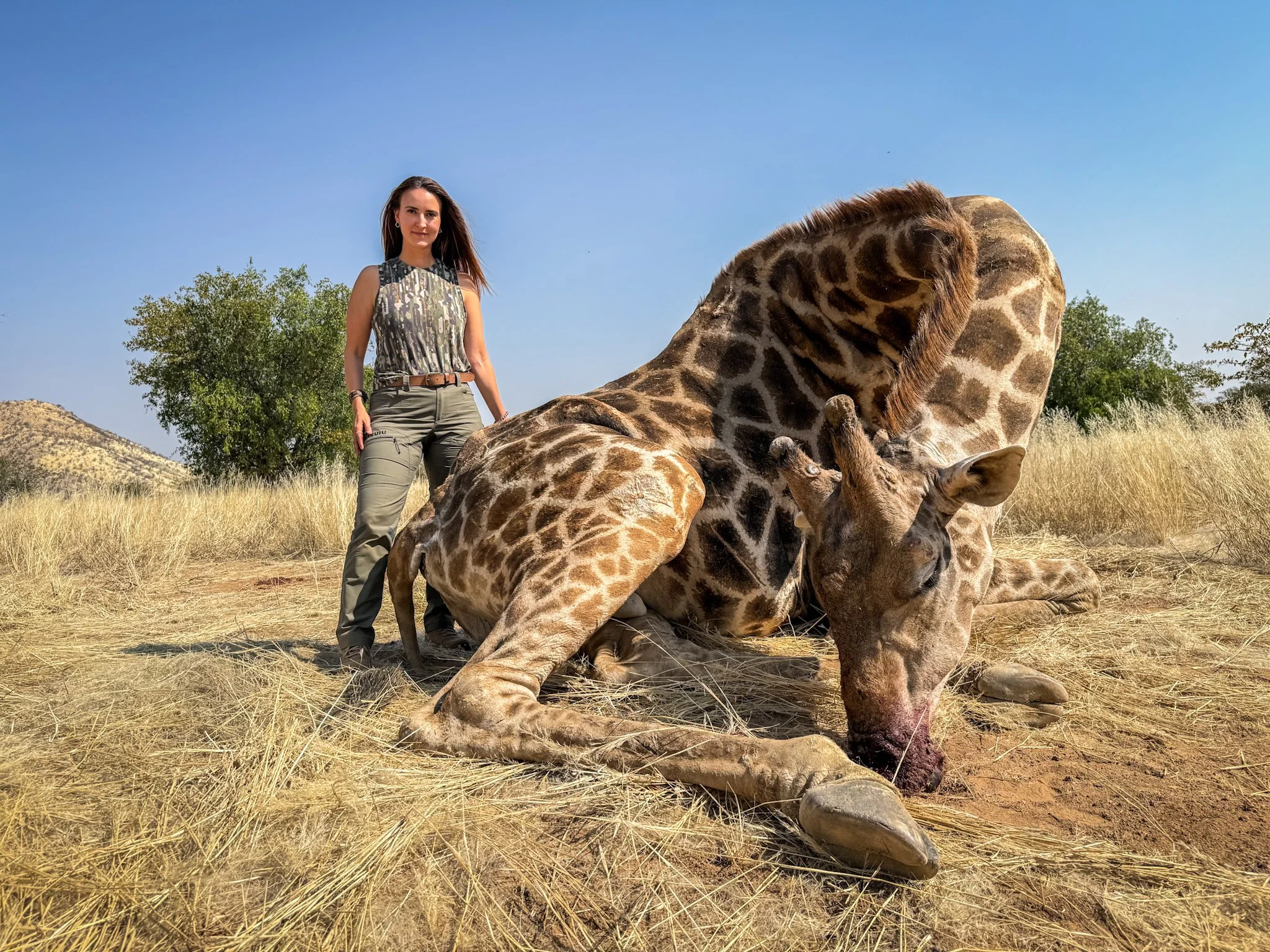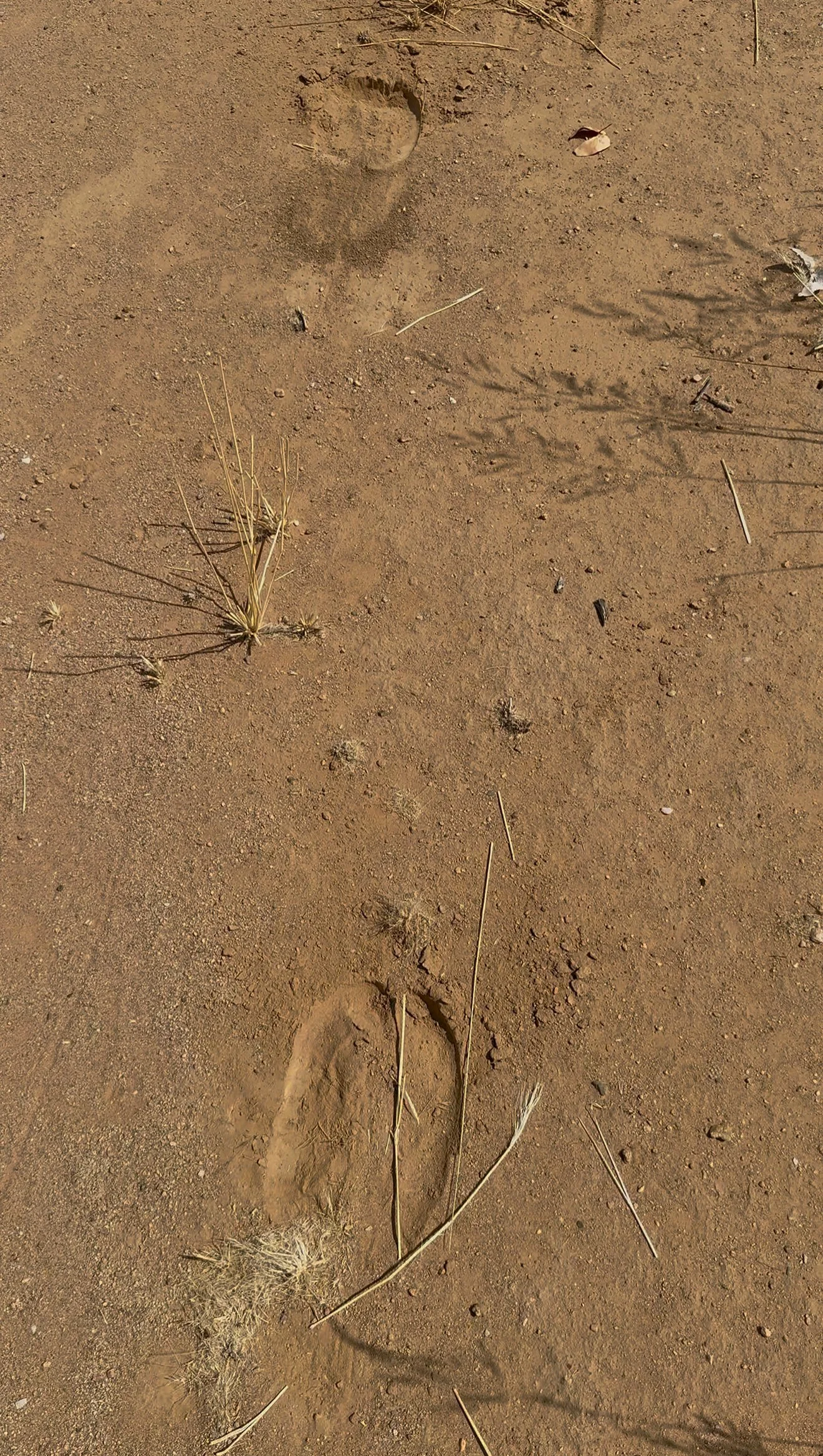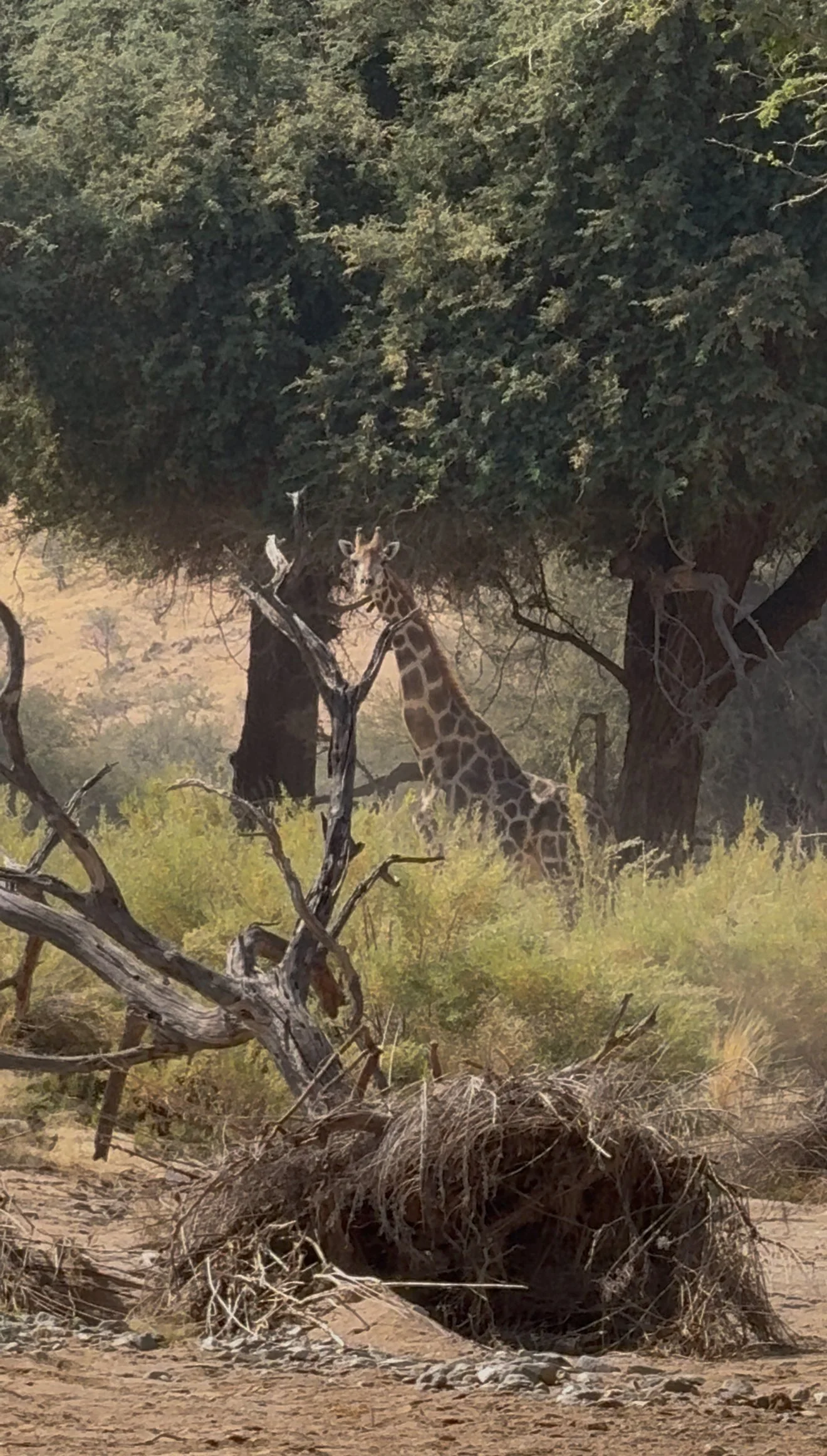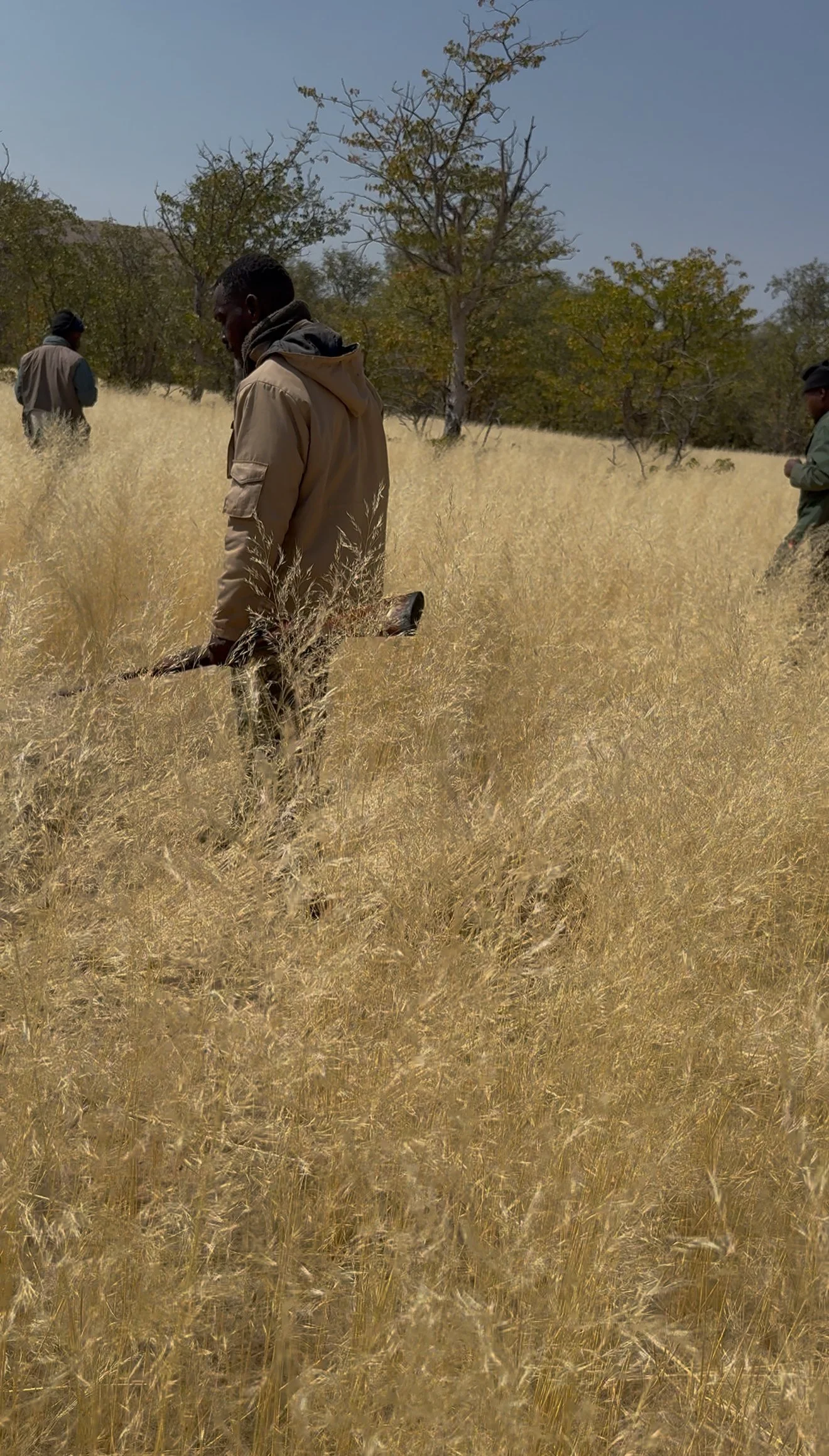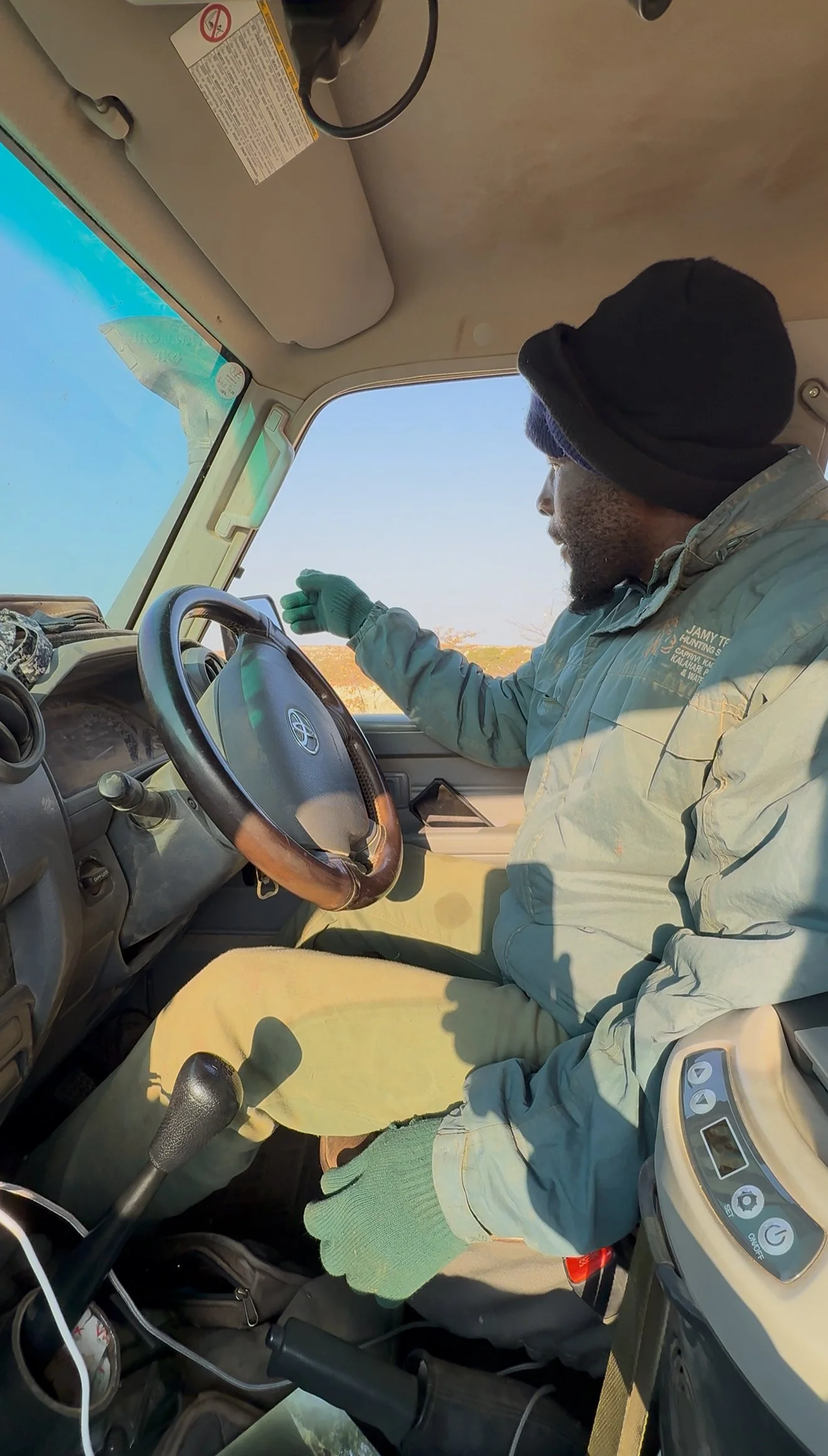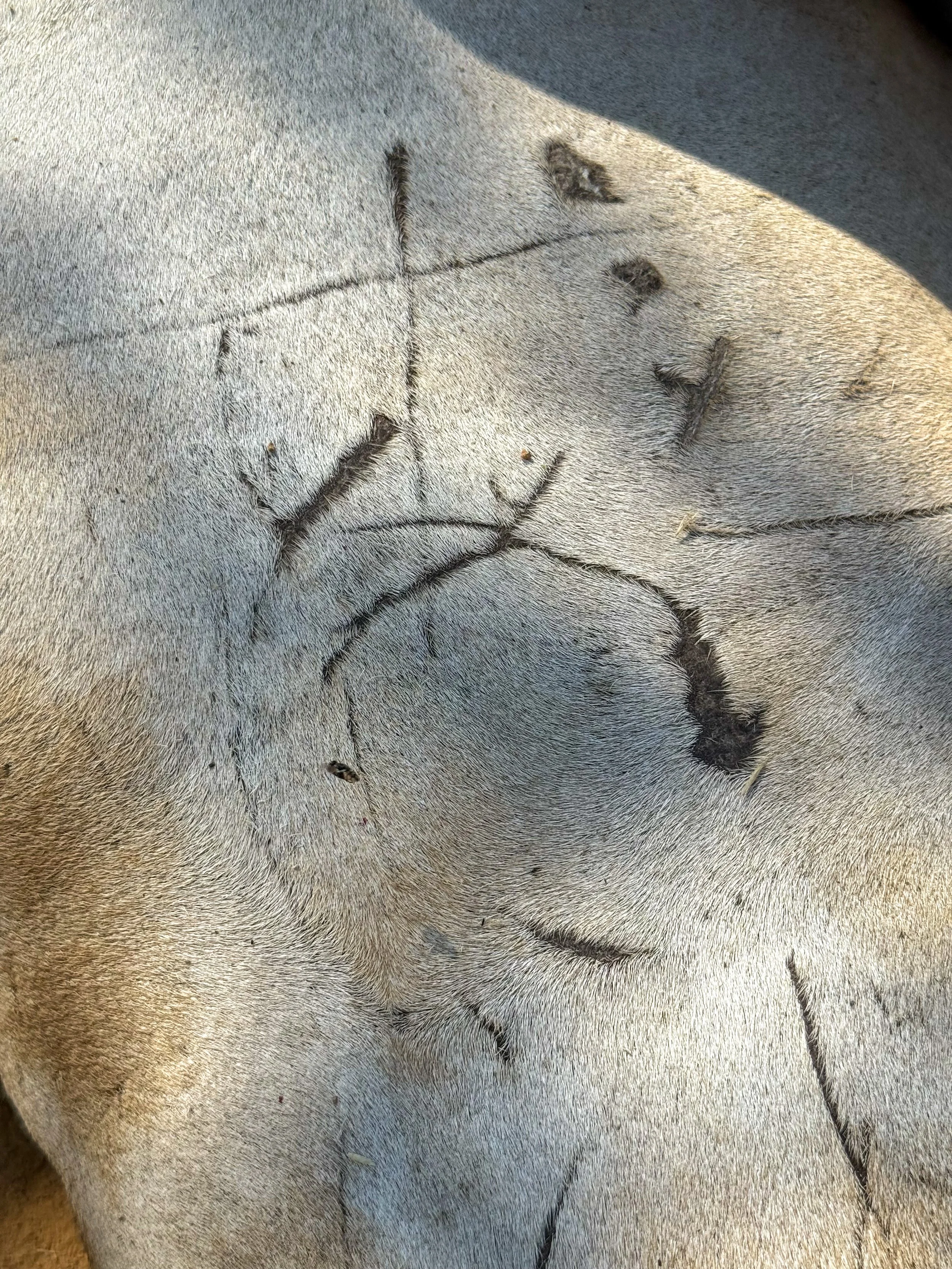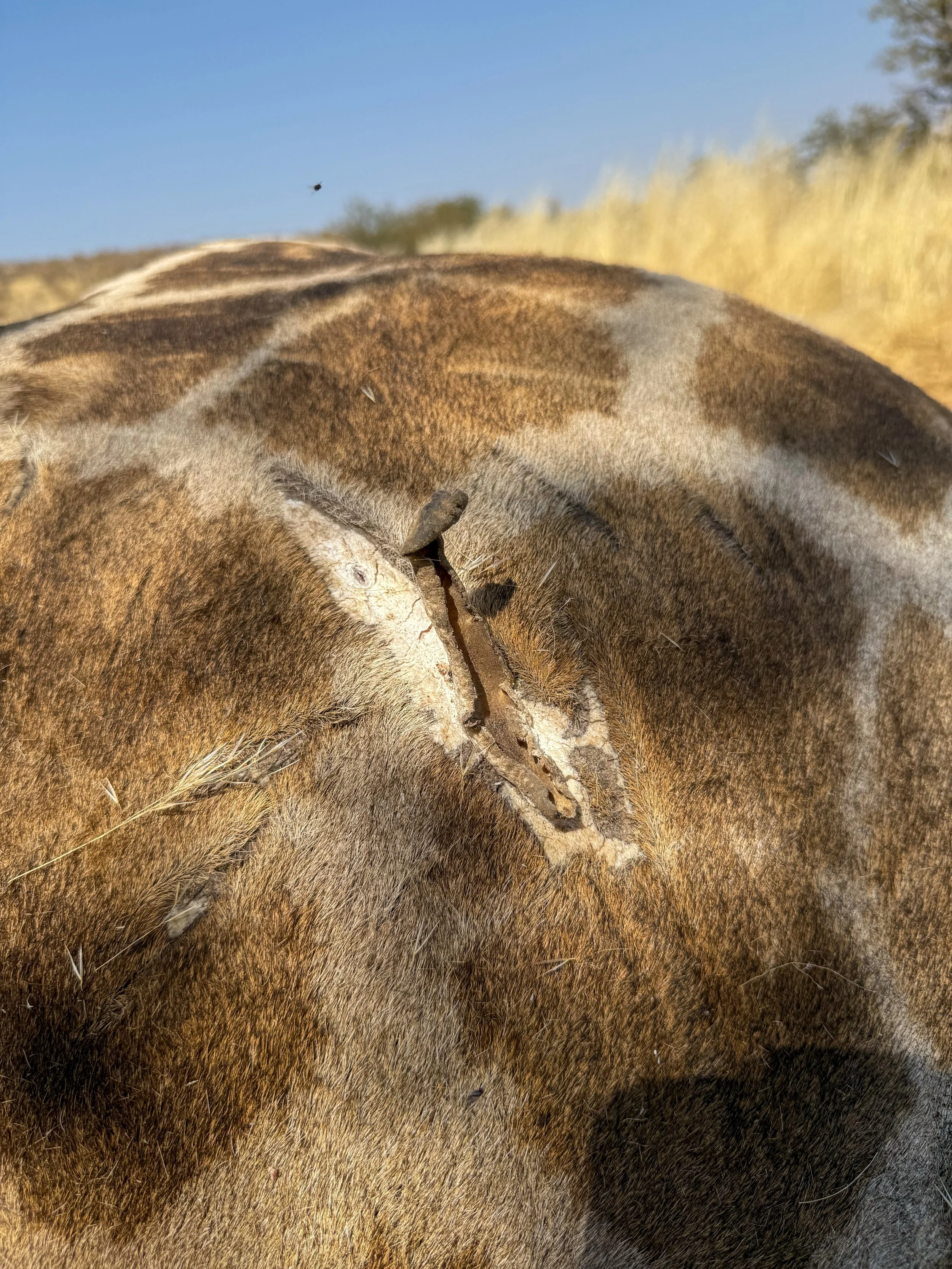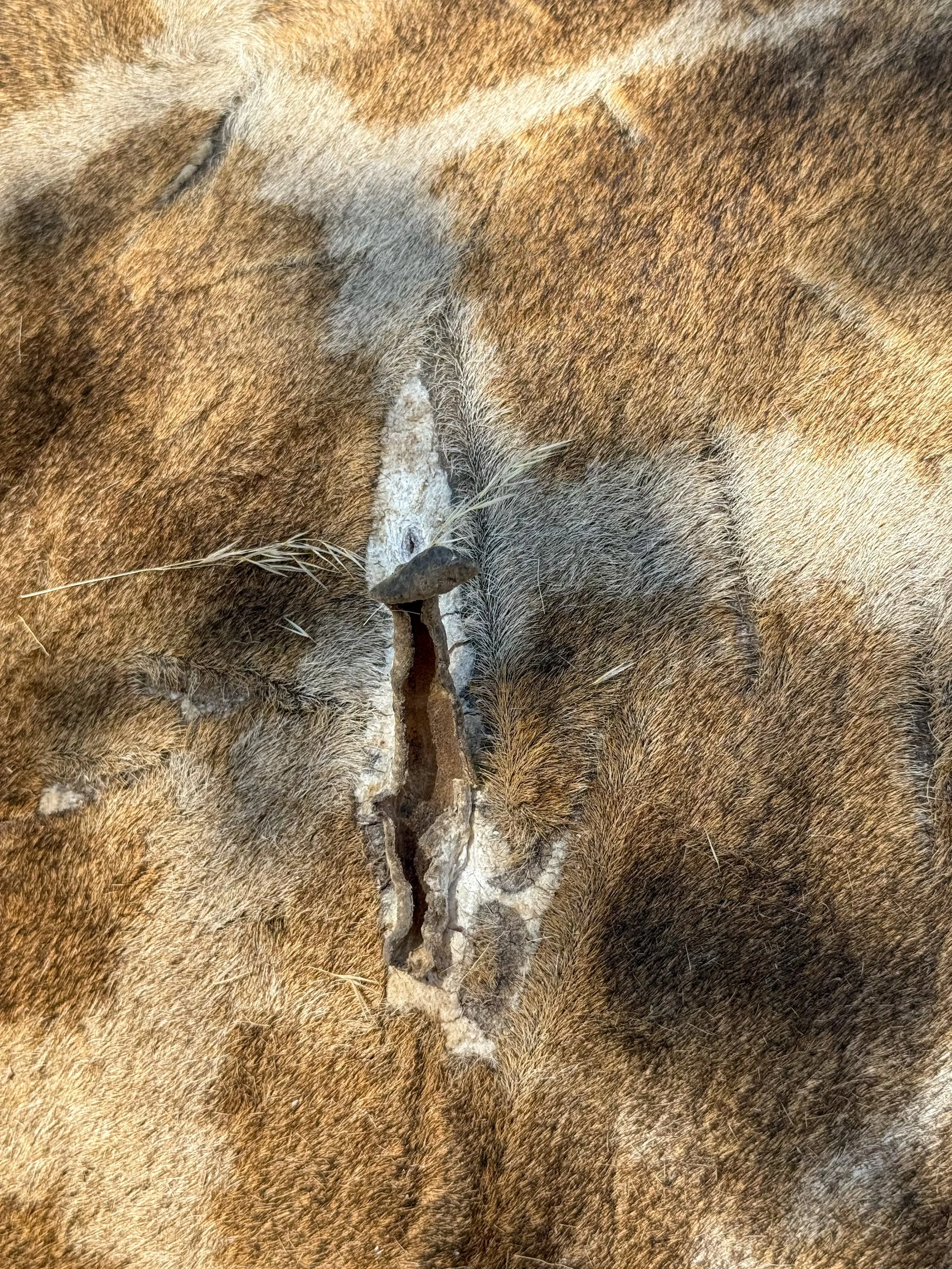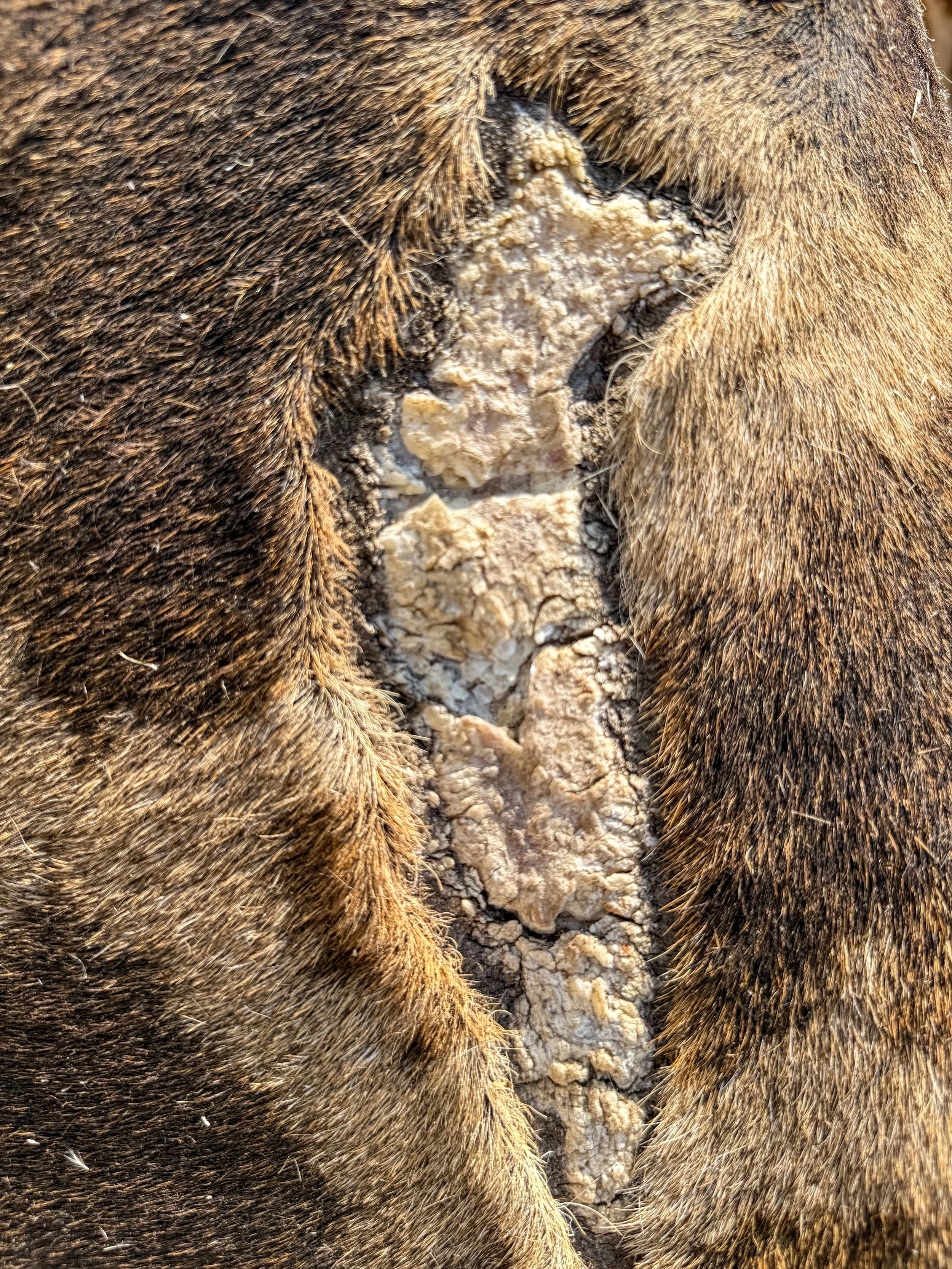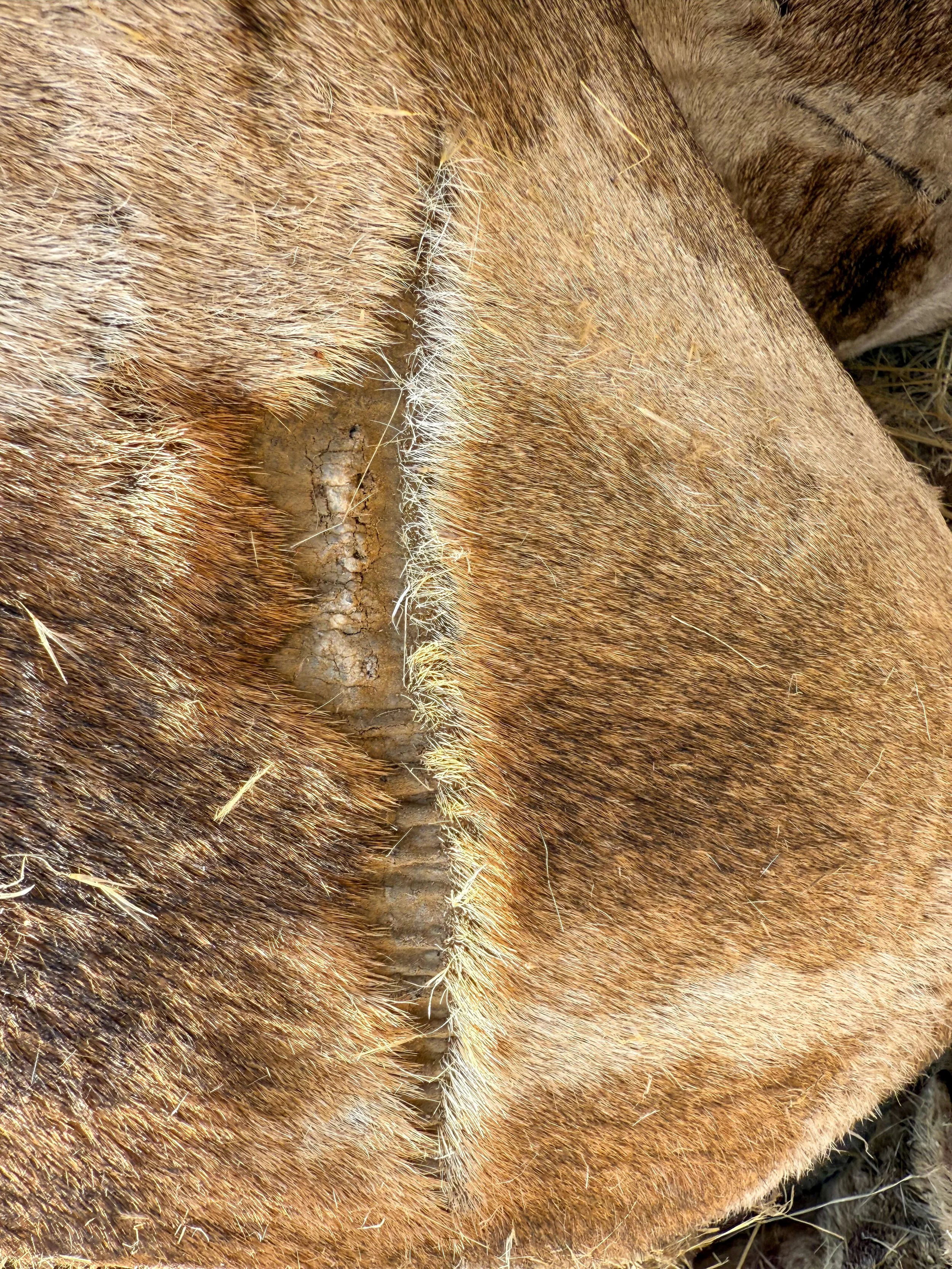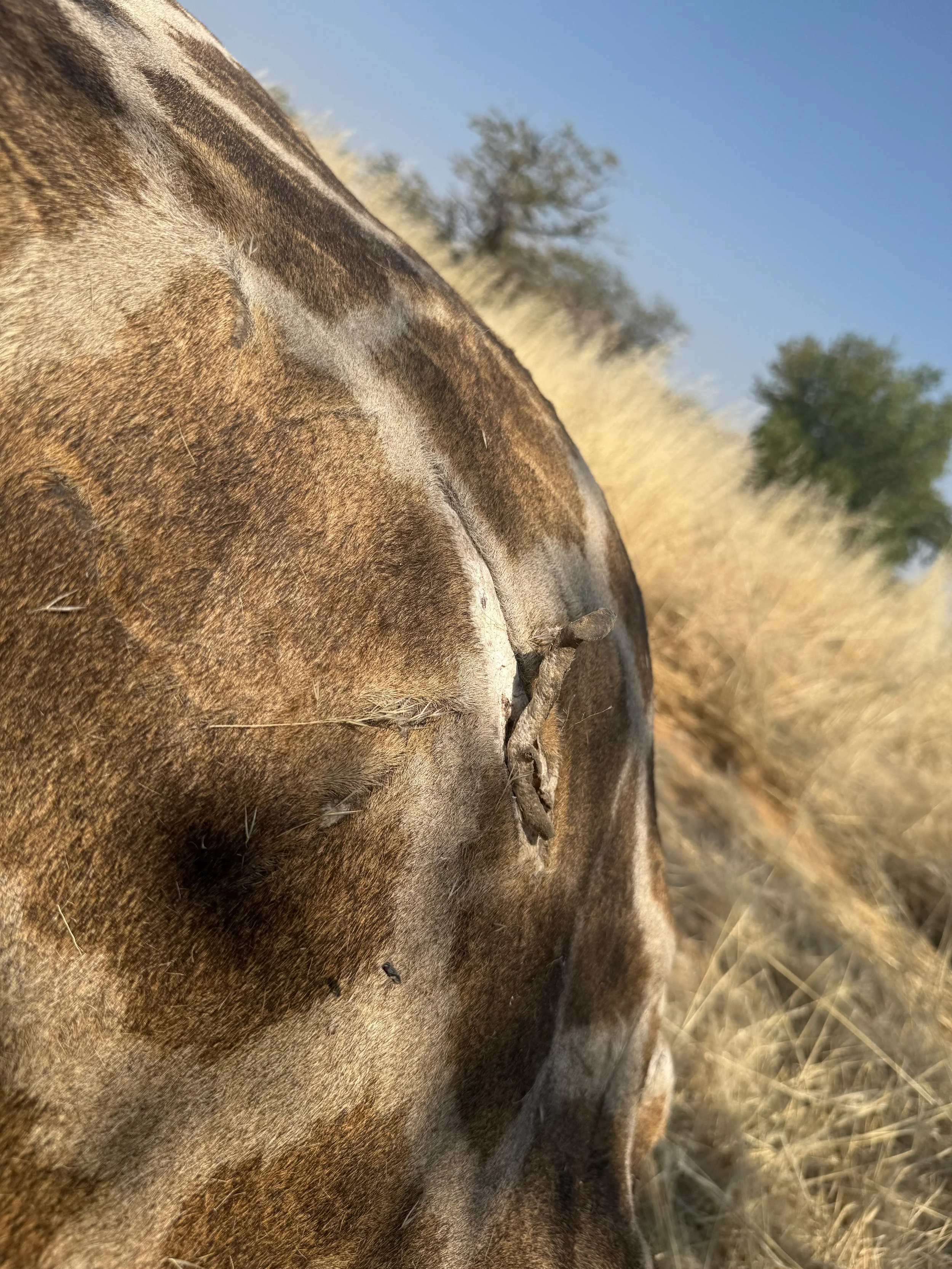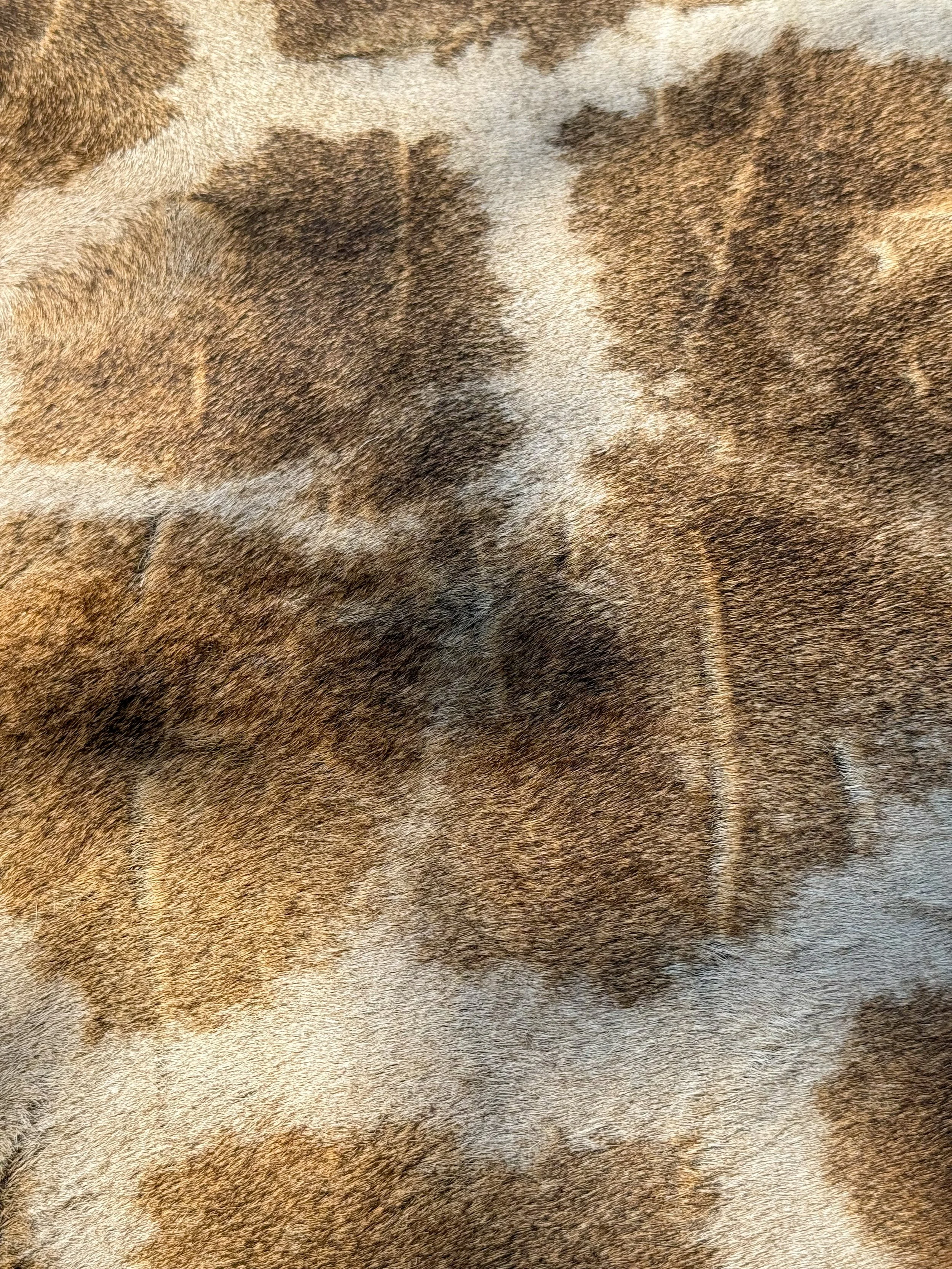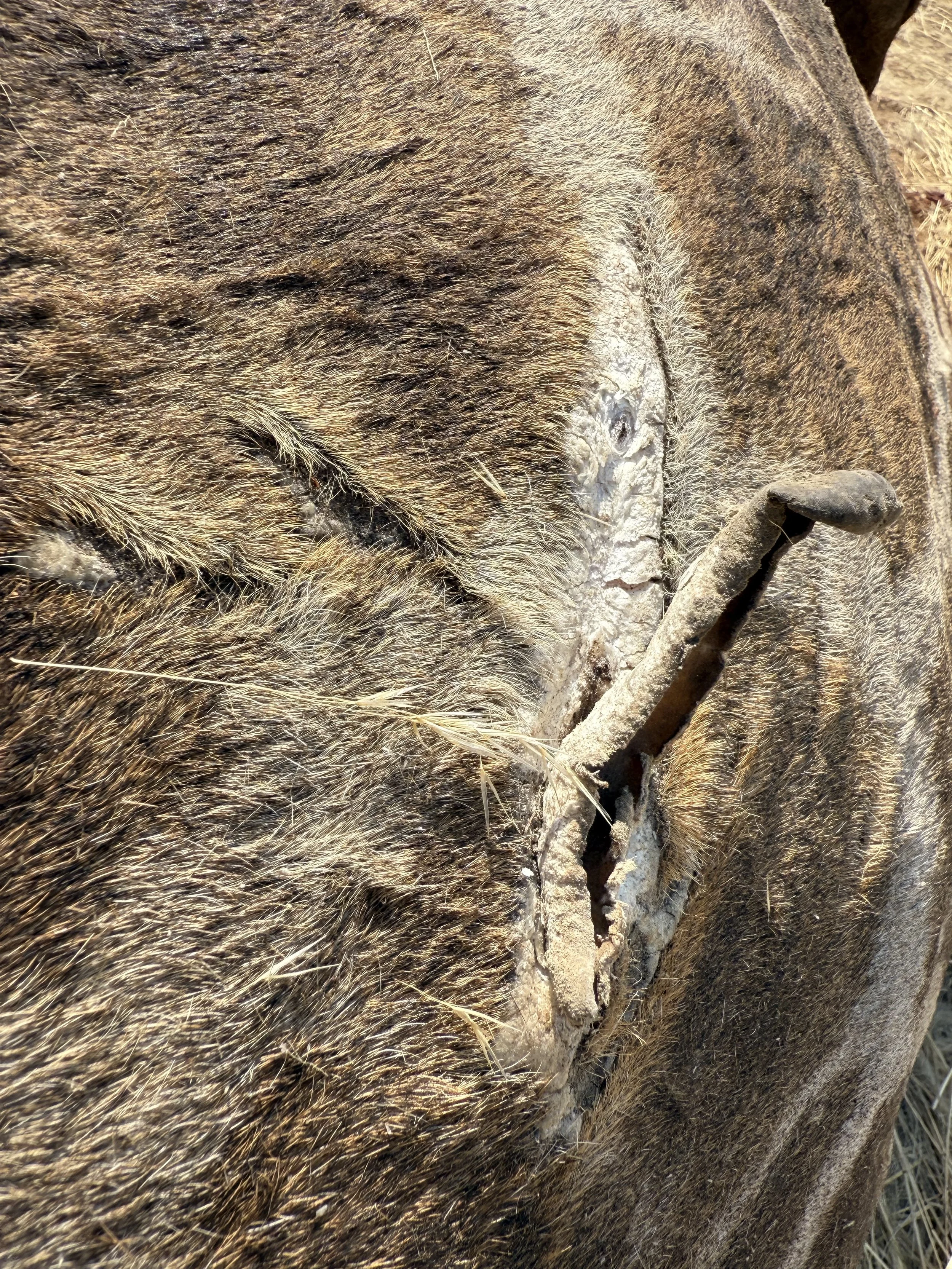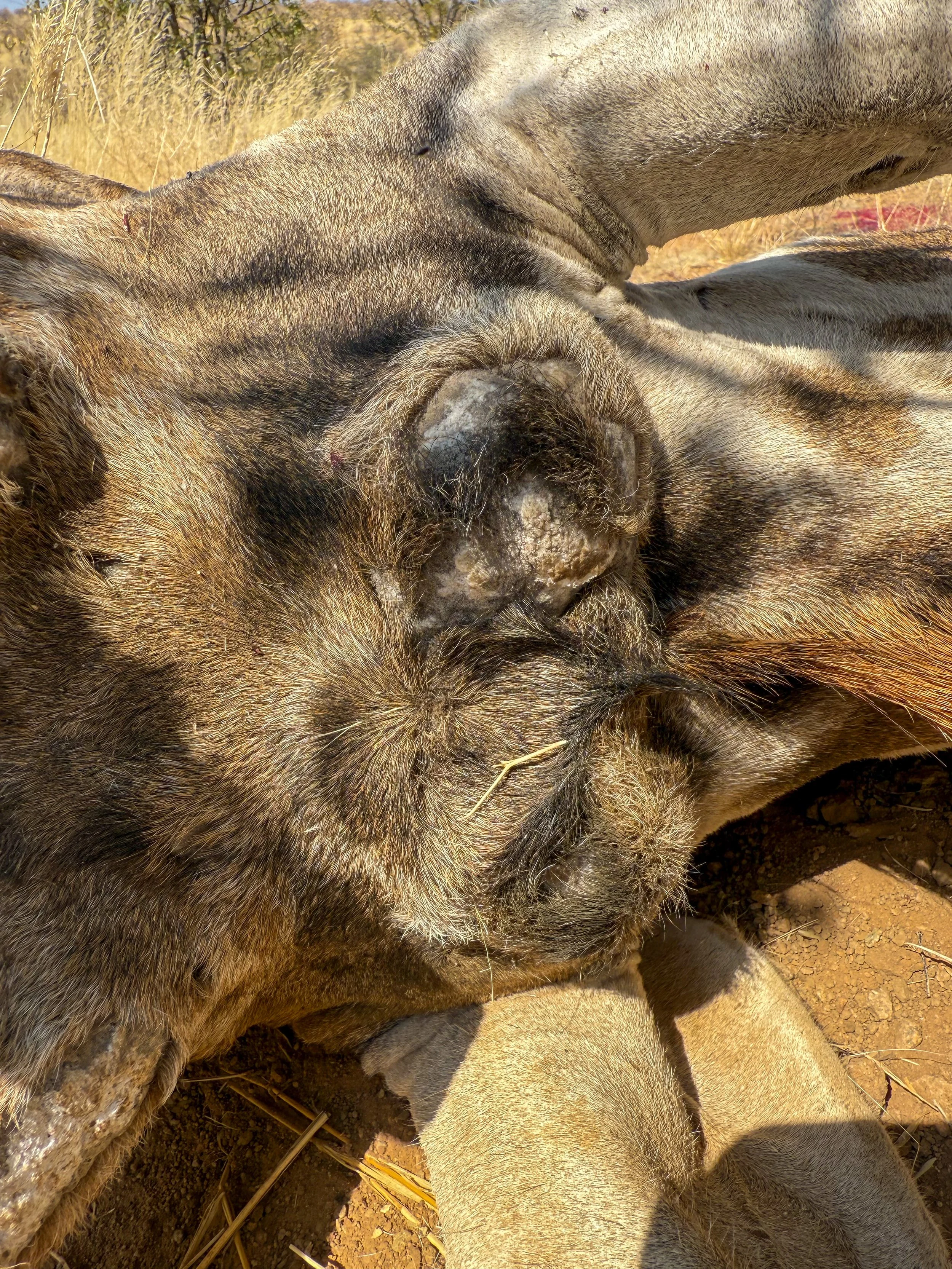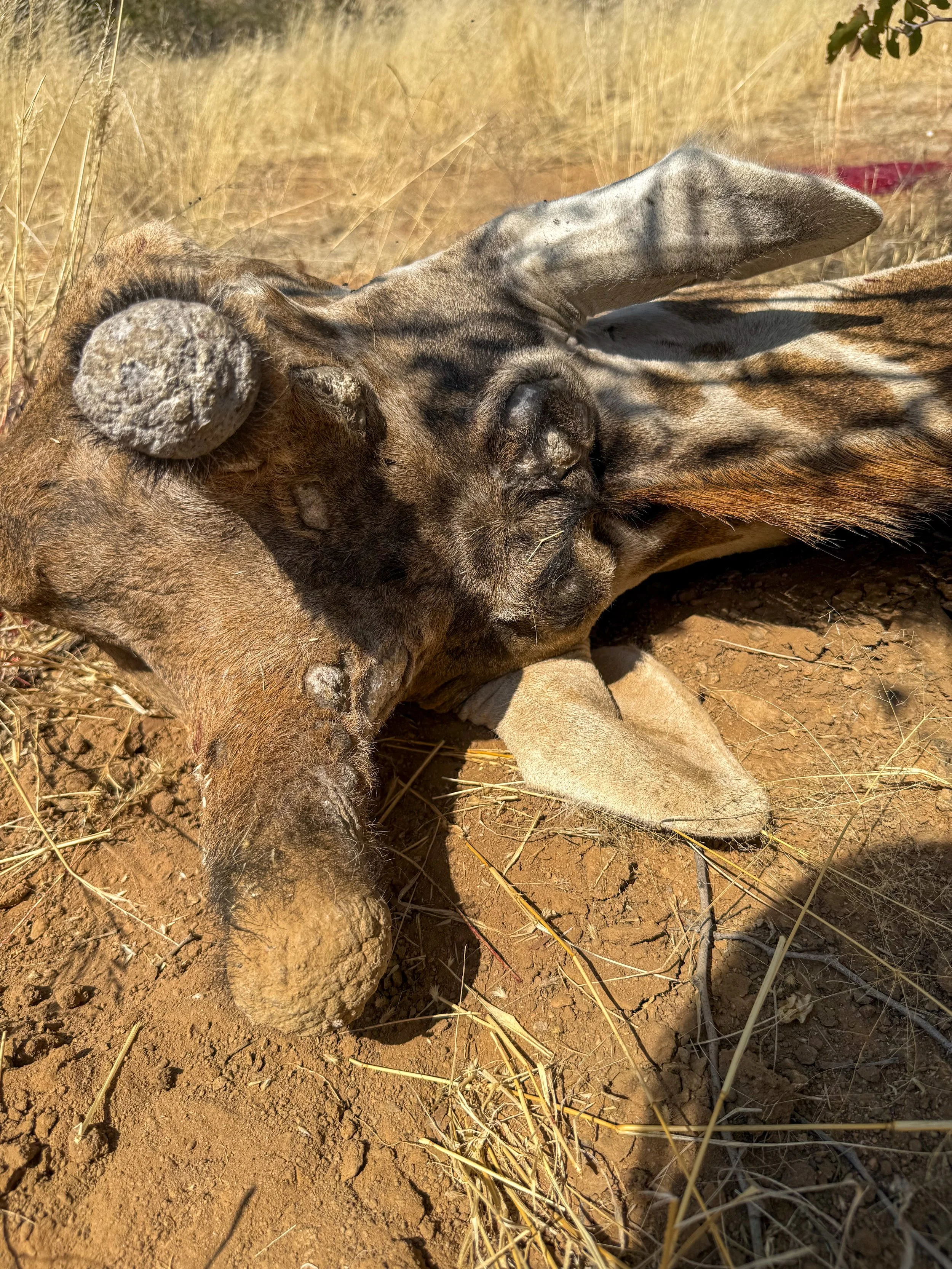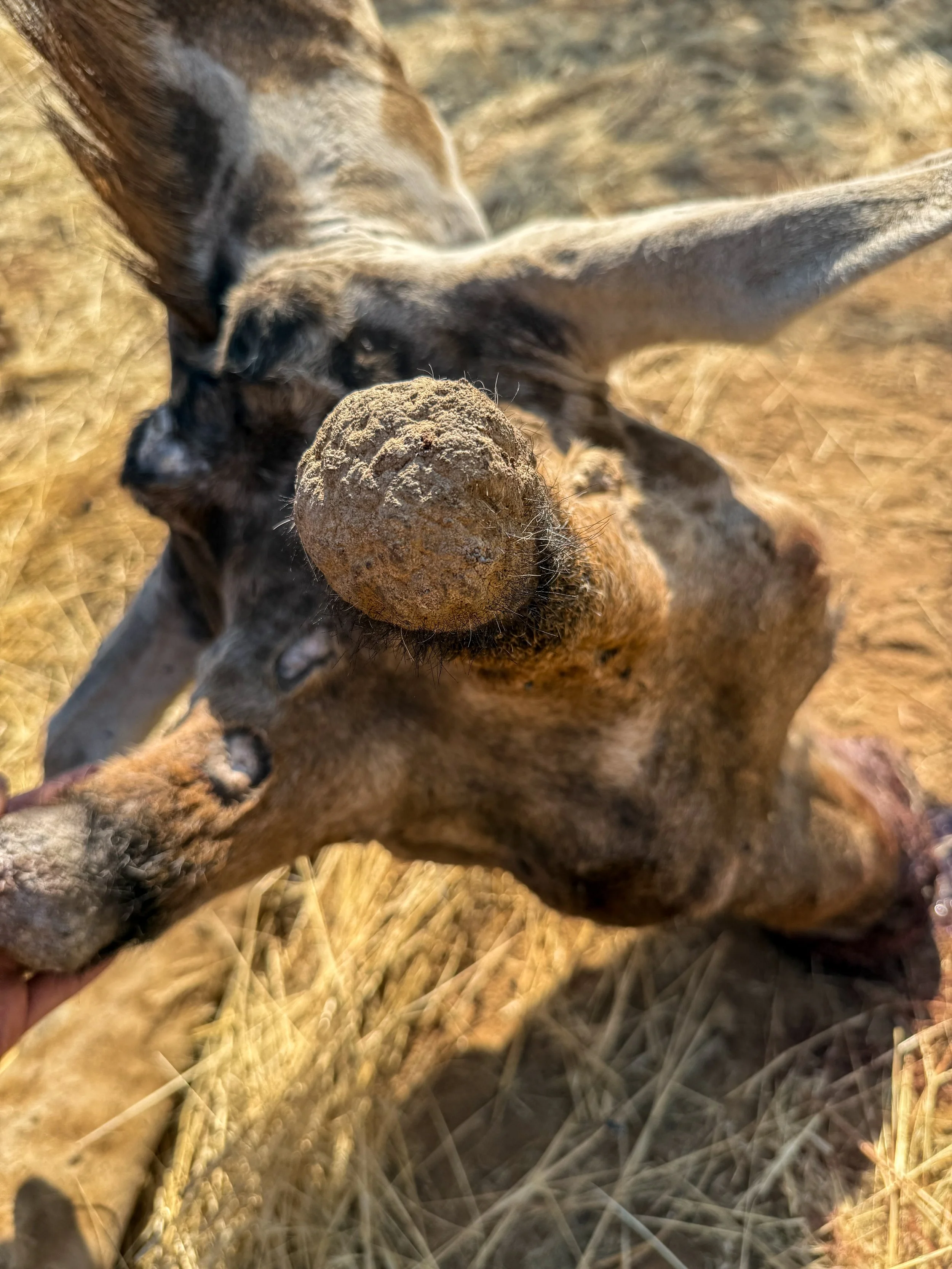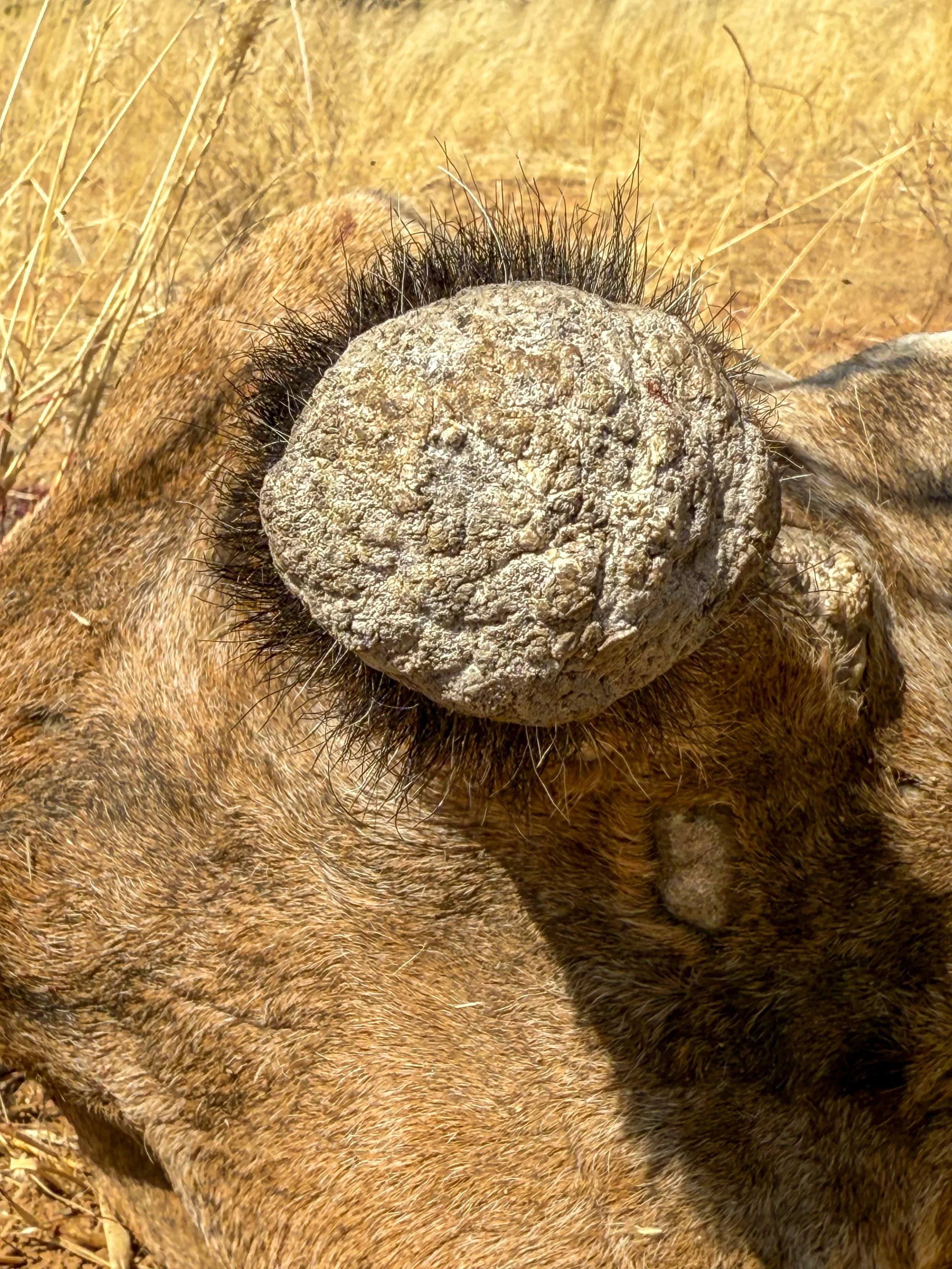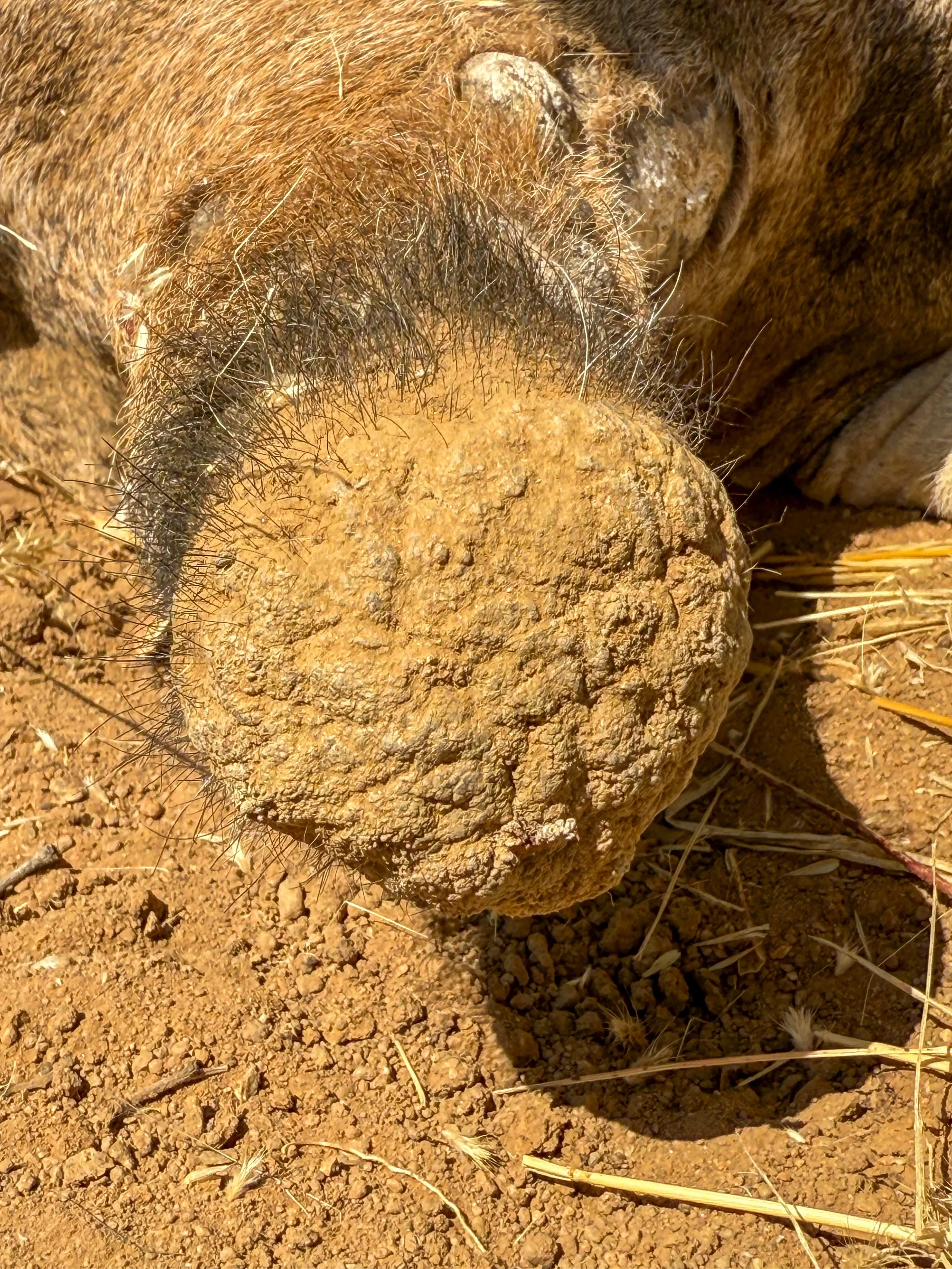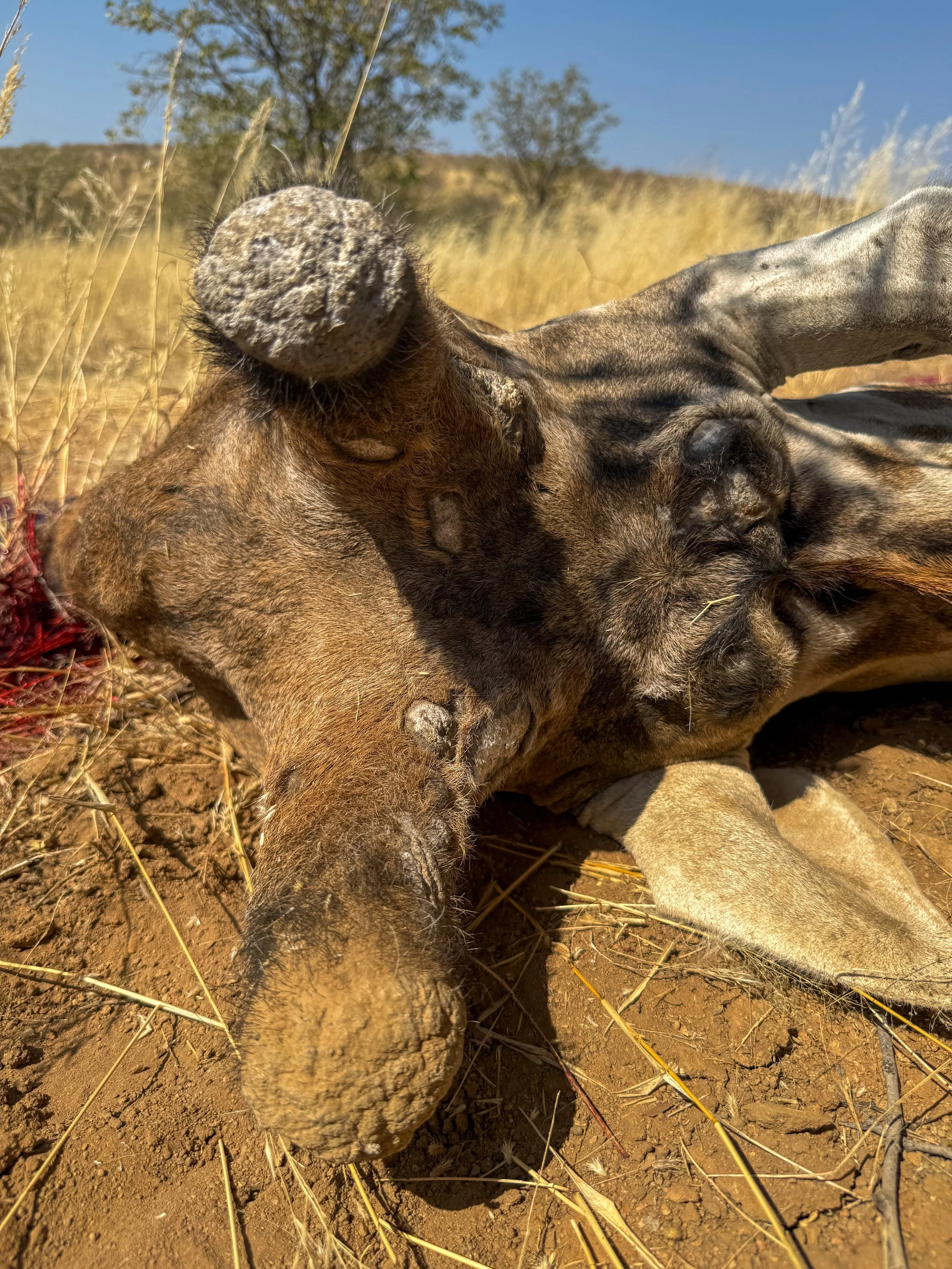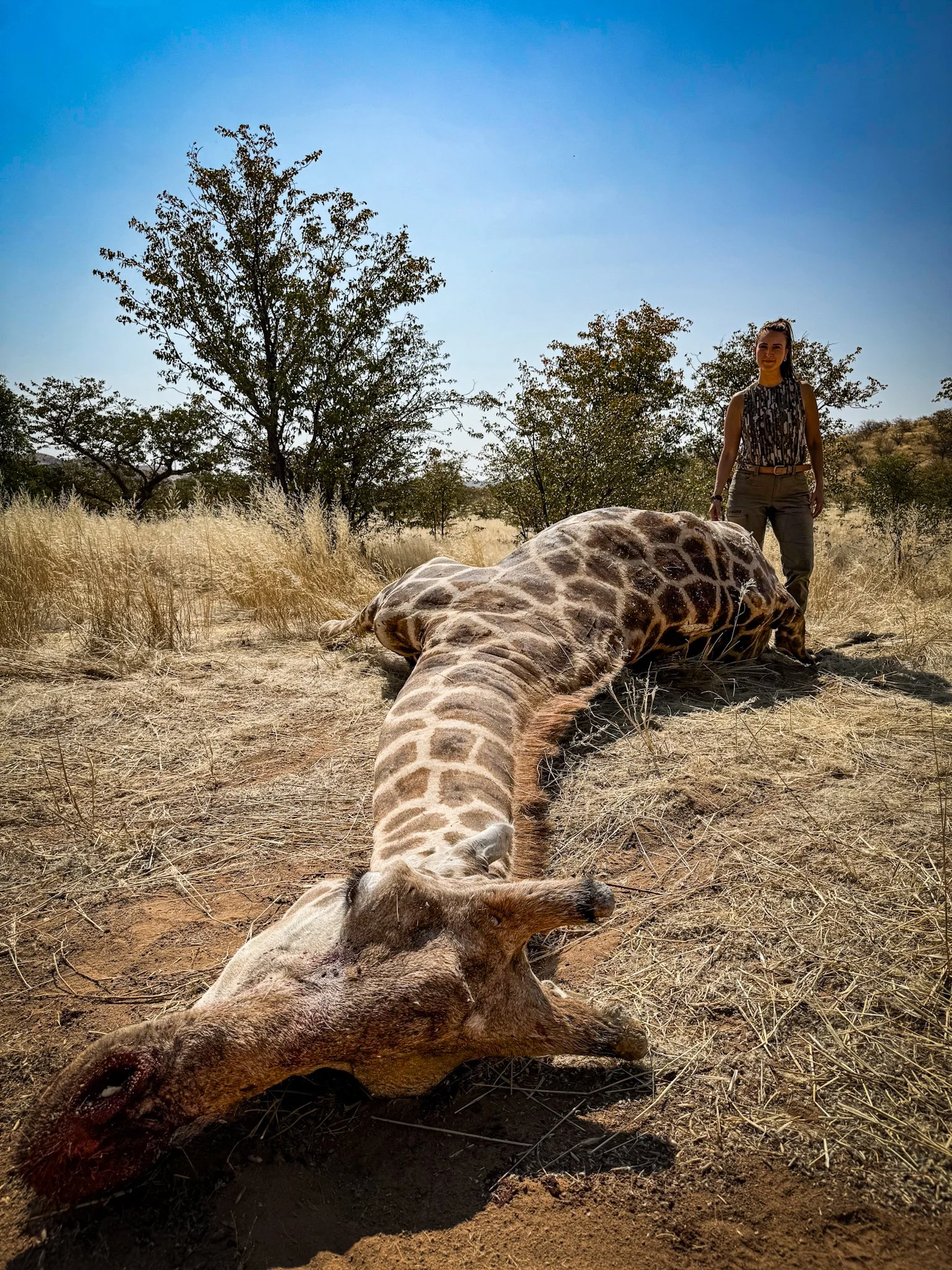Hunting a Giraffe in Namibia: From Doubt to Respect
Five giraffes. One rifle. A year and a half of hesitation. This is the story of how I faced one of the hardest hunts of my life in Namibia’s Kaokoland.
Auction Day at SCI
I looked wide-eyed at the ringman and asked, “Did we win?!” We were at the Ladies Sables Luncheon at Safari Club International’s convention in Nashville, and I somehow found myself bidding on a live auction hunt. Still riding a South Africa high from my first safari just a few months earlier, and maybe a few champagne glasses in, I raised my hand. A hunt package for three game animals in Namibia, and at such a great price if I won it.
I “won.” Or, as my husband would say, I bought it, but at a great deal. My payment, a donation, went toward the SCI Foundation’s education programs. The whole table of women clapped for me as I sat there wide-eyed, half laughing, half in disbelief. This was not planned. Not in the least. But now it was mine.
Then the reality set in.
A giraffe.
Could I actually hunt a giraffe?
Could I Really Hunt a Giraffe?
At first, I thought no. Not because I was against hunting. I was there at SCI after all, but because giraffes, like zebras, had been in a separate category for me. They were zoo animals, childhood book animals, the animals you loved simply for their beauty. Just months earlier in South Africa, I had watched giraffes float across the horizon with a grace that felt impossible for their size. They became one of my favorite animals to watch. And now I was supposed to take one’s life.
My first instinct was to see if I could sub the giraffe out. When I approached the outfitter, they explained that in Kaokoland, where this hunt would take place, quotas dictated what could be hunted. While we discussed that a substitution could be possible, it was unlikely. Old bulls were on the list. The words that stuck with me most were simple: “They feed a lot of people.”
I tucked that away, still unsure what to make of it. I had just gone through an emotional hunt with my zebra a few months prior, one that honestly made me question, in the moment, why I even hunted. That experience had been so heavy that I wasn’t sure I wanted to open myself up to something even more emotional with a giraffe.
Preparing for the Possibility
As I shared my excitement about this Africa trip planned for the following year, the same hesitation circled in my head: could I really do it? At first, my heart hesitated. But if I was going to honor the hunt I had committed to, I needed to prepare for the possibility that I would take a giraffe. And that meant buying my first-ever hunting rifle. Not just any rifle, but one capable of ethically taking down an animal of that size.
Fate works in strange ways. About a month later, I found myself at a suppressor event where Q LLC, the maker of the bolt-action rifle, The Fix, was in attendance. I had already fallen for Q after binging their podcast on my flight home from South Africa, and now here they were in front of me. Q was changing the game, building non-traditional hunting rifles and pioneering a new caliber: 8.6 Blackout.
Most hunters reach for the classic .375 H&H, but I wanted something I could use beyond one hunt. The Fix gave me that. With a barrel swap, I could switch between three different calibers depending on the hunt. Some traditional hunters on forums laughed when I mentioned the 8.6 Blackout, saying it wasn’t enough gun for something as big as a giraffe. But talking to the Q team at the event, they assured me this new caliber had the power, performance, and penetration needed.
Every piece of preparation, from the rifle I chose to the shot placements I studied, pushed me to stop thinking of giraffes as untouchable “zoo animals” and start seeing them for what they are in Namibia: game animals, part of a managed population, and ultimately, providers.
A month later, I had a Q Fix in my hands and made the commitment to myself that I was going to learn how to shoot rifles. This was a big deal. I had never been on a big game–only hunt before, always wingshooting. If I was going to hunt a giraffe, I wanted to do it right. I wanted to ensure I was capable of the most ethical, clean shot — one that would mean minimal pain and a quick death for any animal.
Kaokoland, Namibia: A Year and a Half Later
Fast forward nearly a year and a half, and there I was standing in the sands of Kaokoland, sweat dripping, heart pounding, my 8.6 Blackout Q Fix rifle in my hands. In that time, I had carried the thought of the giraffe with me: the hesitation, the questions, the quiet commitment I had made to be ready.
By day four of my Namibia safari, the zebra and springbok were already behind me. That left only the giraffe. The one animal I had been circling in my head since Nashville. What I didn’t expect was that it would take five different bulls before I finally found myself behind the sticks, staring through my scope at the animal I had once sworn I couldn’t hunt.
1. Nerves + Reality Check
The very first animal we tracked in Kaokoland was a bull giraffe, exactly what I had dreaded and hoped for. Dreaded because it was the first animal of the safari and I still felt uneasy. Hoped for because he was an old, dark giant, and my PH whispered, “This would be an epic bull.”
My heart pounded as we slipped off the truck and began our stalk, but he caught our wind, and he took off. Even if we pushed on, the rocky ground made recovery impossible. My PH shook his head. A giraffe that size, in terrain like that, could leave us stranded with thousands of pounds of meat we couldn’t get out. I felt both relief and frustration as we turned back.
2. Frustration
The second was another old bull, smaller in body but aged in the face, with one horn rubbed bald. We gave him a short stalk, but again the ground betrayed us. No truck could ever reach him. Twice now, it wasn’t my trigger finger that ended the hunt, but the land itself.
3. Anxiety + Patience
We glassed from the top of a mountain. I saw nothing, but my PH, with his trained eye, spotted a dark bull across the riverbed. We tried him twice, following tracks, catching his scent, swatting at mopane “flies” that are more like bees. Each time he slipped away. The trackers pointed us onward, reminding me to be patient. Bush will provide. Still, the nerves churned. This was the animal I had been most anxious about, and he had given us the slip twice.
4. Exhaustion + Respect
The fourth was all grit. We bumped an old bull in the riverbed, and he bolted. The trackers picked up his prints and we followed. Rifle slung, sweat pouring, I peeled layers while trying to keep pace. We pushed nearly two miles through heat and sand before my PH called it off. My body ached, but I also felt something else: respect. To cover that kind of ground, while I carried the weight of my rifle, was a reminder of just how powerful and resilient these animals are.
5. The Shot + Resolution
By the time the fifth bull appeared, I wasn’t thinking about giraffes anymore. We were headed back to camp for lunch, music on in the truck, when the brakes jolted us to a stop. My PH lifted his binos. Within seconds I was out of the truck, rifle in hand, scrambling to the sticks.
This was it.
The Shot
I followed my PH off the truck and we stopped at the edge of the riverbed. The bull was about a hundred yards in. The riverbed sat lower than the ground where the giraffe stood, creating a natural shelf with tall grass for cover. It gave us the perfect setup.
I got on the sticks and found him through my scope. My PH called out the placement: between the eye and the ear. I steadied myself, breath slow, finger on the trigger. And then he turned.
“Now behind the ear,” my PH whispered.
But I froze. Something in me said no. I needed to be certain. We hadn’t talked through that exact shot, and I didn’t want to risk wounding him.
“No. Get him to turn his head again,” I said.
My PH whistled, and the bull shifted just enough.
Now it was a frontal shot. A clean line.
I could feel the mopane flies crawling, landing, swarming around my face, but I locked in. The weight of a year and a half, all the hesitation and preparation, came down to this. I steadied my breathing, pressed the trigger, and the rifle cracked.
Watching Him Fall
The crack echoed through the riverbed, and I saw my giraffe drop. A massive body collapsing into the sand with a force I could feel in my chest. I racked another. But he didn’t take a step.
Relief hit me like a wave. All my nerves about the caliber, the rifle, my own steadiness, gone in that instant. The shot was clean. But then came the harder part.
We rushed forward to where he had fallen, and as we walked up, I was overcome with his presence. A true giant. His chest still lifted, faint and heavy, the final breaths of an animal that had lived nearly two decades in the bush. Tears welled, impossible to hold back.
At my PH’s instruction, I put two more rounds into his chest to help him pass quickly. The first shot had dropped him clean, but with an animal that massive, I didn’t want there to be any lingering suffering. It was the right thing to do.
While he took his final breaths, I whispered, “I’m sorry.” Not for hunting him, but because watching something so immense die is never easy. My PH told me this was normal for an animal his size, that it takes time for life to leave a body like that. But I stayed and watched, because I believe if you take a life, you should witness it fully.
I stood there, tears cutting through the sweat on my face, until his breathing slowed, then stopped.
Scars of a Warrior
After he passed, I stepped closer, reaching out to touch him, to feel his beauty. Standing beside him, I felt small. He was truly a massive creation of God, the most beautiful creature I had ever seen up close. His hooves were smooth on top and rough, like sandpaper, underneath. His hide was thick, his neck solid, his legs made of pure bone wrapped in an inch thick of skin.
Up close, his hide was that dark, chocolatey-brown, the kind of deep coloration that only comes with age. In giraffes, dark hides are the sign of an old bull, one that has lived his years, passed on his genes, and aged out of his role in the herd.
And then we noticed something so unique. Scars. Long claw marks raked across his hindquarters, his back legs, even deep gashes along his back. They had filled with thick old scabs, signs of a lion attack he had survived. This bull wasn’t just old, he was a warrior that had lived nearly two decades in the bush.
And one might think, “And then you took his life.” True, I did. But nature is brutal. Just the day before we came across a fresh giraffe carcass, a bull that had broken its leg and bled to death in the sand.
Many look at giraffes as gentle giants. That couldn’t be further from the truth. They are mean, and they fight. Bulls battle over dominance and breeding rights, especially the older ones, who try to hold off the younger bulls coming up in the ranks. In what’s called necking, they swing their long necks like sledgehammers, whipping their heavy heads with bony ossicones. The blows are violent, sometimes enough to knock another bull off his feet, even kill him. The carcass we saw the day before was from such a fight.
My bull, estimated at 17 or 18 years old, bore the marks of that life. Scars from lions. Ossicones rubbed raw. His head thick with calluses where he had taken hit after hit. He was proof of what it means to grow old in the wild.
And that’s the point of hunting in Africa. Old bulls like him are intentionally targeted. They’ve lived their years, passed on their genes, and often become too aggressive in the herds. By taking an old bull, you’re not removing an animal in its prime. You’re respecting the natural cycle, making room for younger bulls to come up, and providing food for the community in the process.
The Weight of the Work
After returning to camp briefly to pick up more men, it was time to go to work. The team put their skinning and carving skills on display as I set up a time-lapse. For nearly three hours I watched his body transform piece by piece: hide, skull, bones, quarters of meat stacked high.
I’ll eventually bring home the skull for a Euro mount, the full hide for furniture, and the leg bones with hooves intact. The rest, thousands of pounds of meat, went to the conservancy to be divided among the villages tied to this concession. Nothing was wasted. Families would eat because of this bull.
The truck groaned under the weight, tires sagging into the sand. I sat nearby, still staring at the empty space where he had fallen. The mopane flies lingered, the sweat still stung my eyes, but the noise inside me had gone quiet. For the first time since Nashville almost two years ago, I felt a shift. From dread, to responsibility, to something closer to peace.
Reflection
Looking back, this hunt taught me more than I expected. It taught me a new element of hunting: rifle hunting. It taught me to be patient, to wait for the right shot, and to trust that the bush would provide. After five bulls, it did. And not just any bull, but a warrior who had lived nearly two decades, survived lions, fought off rivals, and carried the scars to prove it.
And here’s one thing many people get wrong: this kind of hunting isn’t about taking away. It’s about making sure wildlife thrives. In Namibia, giraffe numbers have steadily increased in places where conservation programs, community conservancies, and regulated hunts are part of the landscape. Hunting fees pay for anti-poaching, habitat upkeep, and provide direct incentives for communities to protect the land. Without those incentives, habitat gets lost, animals decline, and wildlife areas shrink. We have seen this in Kenya after decades of bans on hunting, while countries like Namibia and South Africa have watched populations grow under regulated use.
Organizations like The Origins Foundation tell stories exactly like this one. They emphasize that when wildlife has economic value through legal and ethical hunting, land remains wild, local communities benefit, and species like giraffes thrive.
So when people ask me, “Why would anyone hunt a giraffe?” my answer is simple. Because hunts like this provide. They provide for conservation, for communities, and for the future of these wild animals. And this hunt gave me something too: a deeper respect for the animals, for the land, and for the responsibility we carry when we choose to hunt.
Want to know when I share my next story?
Sign up through the link below to get updates straight to your inbox.

